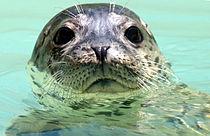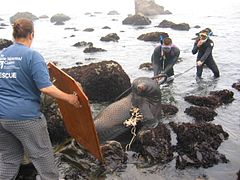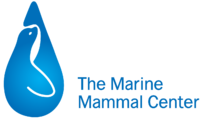- The Marine Mammal Center
-
The Marine Mammal Center is a private non-profit U.S. organization centered established in 1975 on rescuing, rehabilitating, and releasing injured marine mammals. It also serves as a center for environmental research and education regarding marine mammals, namely cetaceans (whales and dolphins) and pinnipeds (seals and sea lions). The Centers' primary mission is to take in animals that are not able to survive in the wild, diagnose them, rehabilitate them, and, if possible, release them back into the wild.These animals strand along the Pacific Coast of the western U.S. and represent the following major species: California sea lion, Northern elephant seal, Pacific harbor seal, fur seal, dolphin and the endangered Southern sea otter. The only non-mammal that the Center takes in are sea turtles which should not normally be found in the cold waters off Northern California.
Facilities include the Marin Headlands headquarters, California field stations in San Luis Obispo, Monterey, Anchor Bay and an interpretive center at Pier 39 in San Francisco.
Contents
Research
The research team consists of veterinarians and biologists, who conduct not only medical diagnosis and intervention, but also publish scientific reports on marine animal health in relation to the Pacific Ocean’s environmental chemistry. They collaborate with other selected technology centers to provide vital information on disease, immunological systems and environment effects. The center collaborate with counterparts around the world (most notably from England, Canada, Mexico, Brazil, Australia, Scotland, the Netherlands, France and Germany) in working on complex cases, and also jointly research interactions of ocean-dwelling mammals with the marine environment. Researchers at the Marine Mammal Center have discovered that Domoic acid (DA) is the causative agent responsible for illness in a great many CA Sea Lions. DA is naturally produced by the diatom Pseudo-nitzschia and harmless to fish, but builds up through the food chain as it is consumed by zooplankton.
Another discovery by The Marine Mammal Center in collaboration with the University of Florida is that seal pox is distinct from pox viruses isolated from other species. It is unrelated to chicken pox or smallpox. Also being investigated is the increased incidence of leptospirosis, a bacterial pathogen that can acutely damages the kidneys of marine mammals.
Education
The education outreach program reaches in excess of 100,000 school children and adults each year, emphasizing man’s connection to the marine environment.
 Pacific harbor seal in recuperation pool at the Marine Mammal Center. Photo Credit: The Marine Mammal Center
Pacific harbor seal in recuperation pool at the Marine Mammal Center. Photo Credit: The Marine Mammal Center
Rescue and rehabilitation
Sometimes release is not a viable option. If an animal is released and returns two times in a row, it is deemed unreleasable and a permanent home must be found for it. If an animal becomes unafraid and attached to people, it becomes a poor candidate for release. If an animal is released twice and returns to the center twice, it is deemed un-releaseable.
Facilities, budget and governance
The yearly budget of the center is $5,000,000. 87% of expenditures go directly to animal care, veterinary expense, and education programs. The present facility is staffed by 45 paid and 800 volunteers and can accommodate approximately 1,200 animals a year. However, in 2009, the Center saw 1,750 patients, more than in any year since it opened. Eighty percent of the Marine Mammal Center's operating budget comes from private donations and one-fifth of the total budget comes from fairly small donations between $25 and $250. Individual membership starts at $25 and gives members an opportunity to watch an animal release, attend guest lecturers, and a 10% discount at the gift shop.
Growth
The Marine Mammal Center began in 1975 with a single bath tub or kiddy pool with a fence around it. In June, 2009 a multi-facility complex was opened to hold both the animals and the staff. It was built with recycled materials and utilizes sound boards made of sea weed. Solar panels we placed over the animal pens which feed approximately 10% of the facilities energy grid. 80% of the water is reuseed.
During the reconstruction, numerous outdoor pens with pools and haul-out surfaces were created; there are also special purpose facilities including a veterinary hospital, records room, food preparation and storage rooms and rescue equipment storage area. The hospital includes an operating room, treatment areas, office and pharmaceuticals storage. Some of the hospital functions include thoracic surgery, gastrointestinal surgery, and orthopedic surgery as well as routine examinations and blood sampling for patient diagnosis.
 Anesthesia being delivered to a juvenile elephant seal prior to surgery. Photo courtesy: The Marine Mammal Center
Anesthesia being delivered to a juvenile elephant seal prior to surgery. Photo courtesy: The Marine Mammal Center
 Personnel from The Marine Mammal Center rescue an adult sea lion Photo courtesy: The Marine Mammal Center
Personnel from The Marine Mammal Center rescue an adult sea lion Photo courtesy: The Marine Mammal Center
Notable actions
Some specific examples among the thousands of successful outcomes are:
Net entangled Humpback whale. In December 2005, a large female Humpback whale was rescued off of the Farallon Islands, after she became entrained in crab pot lines on her migration, most likely to wintering grounds near Mexico. The daring maneuver was carried out by Center staff and volunteers along with professional divers and was the Center's first successful open ocean rescue of a whale entangled in netting.
Orphaned Steller sea lion pup at Ano Nuevo Island. In the year 1999, a malnourished 37 lb (17 kg) pup was found stranded alone at a location known for Northern elephant seal rookeries, but not as a birthing location for stellar sea lions. The pup, now named Artemis, was restored to health and returned to the wild. In July 2005, she was again spotted on Ano Nuevo Island, but this time she was giving birth to a new pup. This was a particularly unusual outcome, since no pup is known to have been born on that island for at least twenty years.
Humphrey the whale is arguably the most widely publicized humpback whale in history[1] [2], having errantly entered San Francisco Bay twice, departing from his Mexico to Alaska migration. Each excursion resulted in dramatic estuarine rescues in 1985 and 1990 by the Center, assisted by the United States Coast Guard and hundreds of volunteers. The first rescue was actually to turn Humphrey around in the Sacramento River, while the second was to unbeach him from the mudflats north of Sierra Point below the Dakin Building.
Baker D., a bottlenose dolphin was successfully rehabilitated and released to join a dolphin pod in Monterey Bay in November 2004.[3]
See also
- Cetacean Conservation Center
- Domoic acid
- Endangered species
- Moss Landing Marine Laboratories
- Institute for Marine Mammal Studies
- Red tide
-
Pacific Harbor Seal pup. Rescued for maternal separation, malnutrition, and trauma. He was released six weeks later.[citation needed]
References
External links
Categories:- Environmental organizations based in the United States
- Oceanographic institutions
- 1975 establishments
- Wildlife rehabilitation
- Wildlife rehabilitation and conservation centers
- Non-profit organizations based in California
- Buildings and structures in Marin County, California
- Visitor attractions in Marin County, California
Wikimedia Foundation. 2010.




